Report on Tomb Measurement Workshop
5
by Joshua Ng
Instead of enjoying a quiet and uneventful Saturday, I chose to spend it at a live tomb measurement exercise. Armed with a trusty can of mosquito repellent, jeans and covered shoes, I arrived at the Bukit Brown Main Gate at 3.30pm. It was 35 degrees Celsius and I started to doubt my decision.
After a round of introductions, I was assigned to a team with Wei Ming (the drawing maestro), Andrew and Simone who are Brownies (volunteer guides). We had met briefly during the previous week’s theory and briefing workshop at NLB.
Our assigned tomb was Tan Ean Kiam’s wife, Ye Yan Niang (葉焉娘). Our task was to measure and draw the front view, section view and the plan view of the tomb.
Initially I was wondering why we needed four people to measure a tomb. It only made sense when we began our work. The curves, elevation and non-rectilinear structure makes it really hard to get an accurate reading. We had to use strings, bamboo sticks, IKEA flexible paper rulers, a metal tape measure as well as insect repellent to get it done.
The little insects that make their homes around the tomb were not amused — I even got a few ant bites on my hands. Some even crawled up my covered shoes and jeans and bit my calves.
Thankfully, after three hours of hard work, we finally finished our sketch. Our drawings were not the best. We committed at least one mistake, which was to assume that the sides are mirror images of each other. Chee Kien told us that we should not assume but measure and draw the tombs just as they are found. He pointed out that sometimes in a “couple” tomb, part of the tombs may be intentionally elevated so that the “water” will flow towards the descendants of one side.
This is not the first insight I gained from these two weeks of tomb measuring. I also learned that the different dialect groups have very different tomb designs. The one we measured clearly had a Hokkien design. Besides that, only the tombs in Bukit Brown have special bricks backing behind the head stone. It would have been very expensive to import bricks from China, so brick making was one of the earliest industries in Singapore.
As our assigned tomb was Tan Ean Kiam‘s wife, I figured he must have been some important person. I looked him up and found out that he was one of the founding members of OCBC Singapore. And he was also one of the founding members of the Tong Meng Hui (同盟会), which supported Sun Yet Sen’s revolutionary effort.
Another unique feature of this tomb is that the history of Mrs Tan was written by Tan Ean Kiam himself. According to the Brownies, Tan Ean Kiam’s own handwriting was inscribed on the body of the pedestal altar. Other than the fact that Tan Ean Kiam was alive when his wife passed away, we also know that he must have loved his wife a lot to do something so unusual as to personally inscribe her life story.
What amazed me the most is the fact that such a simple exercise like tomb measuring could connect the dots in my understanding of those who went before me. It makes me wonder what interesting facts I can discover from my grandparents’ tomb. Qing Ming (清明) would have been more fun if we were told about all these unique cultural factoids.
Mrs Tan’s tomb is just one tomb. There are about 4,000 tombs that are going to be destroyed without proper measurement and documentation because of the building of a highway that will cut Bukit Brown into half. Who knows what other important life insights we might have missed by not preserving and treasuring the stories of those who went before us.
There are 100,000 graves at Bukit Brown. Imagine how much time and effort will be needed to document them all. And as a digital heritage enthusiast, I can’t help but wonder if there could be better and faster ways to do this. Looks like my journey have just begun.
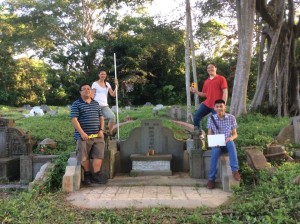
One for the album with the full team. Andrew on the left , Simone, Joshua and Wei Ming with his drawing, (photo Ee Hoon)
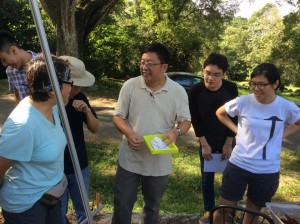
Dr Lai Chee Kien (third from left) sharing a light- hearted moment with his students (photo Ee Hoon)
***
Editors note
Documenting and taking precise measurements provide valuable data to analyze the proportions and variations through IT applications and ultimately relate it to Feng Shui. Tombstones are not just built, they are “feng shui’ed” Citizenry participation in a project like this is crucial because of the sheer size of Bukit Brown and because it signals a deeper engagement of ordinary people in wanting to understand all aspects of Bukit Brown. So kudos to Lai Chee Kien for this initiative and the first batch of participants for signing up. Hopefully there will be more.
What the tomb measurement workshop covered here.
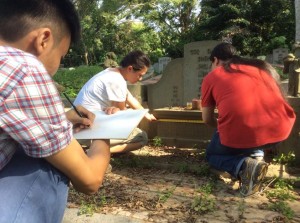
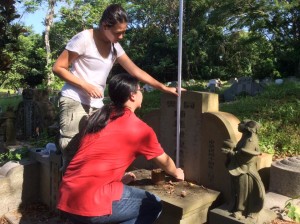
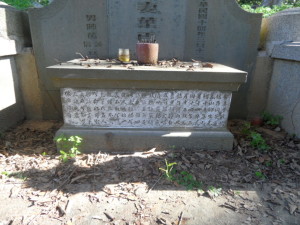
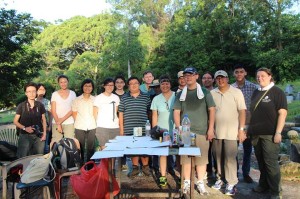
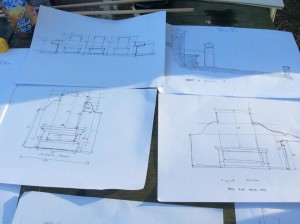

Joshua
I do hope you will find the time to read more from the tombs and find out about the stories these stones can tell. Qing Ming is about reverence of one’s ancestors and that isn’t only about waving joss sticks and burning papers: it should be about telling stories of old, the family, the tomb, the people. In the telling of the stories petiole love again in our memories. Well now you know. .. Time to bone up on those stories before the next qing ming!
Thanks Darren, I will!
This article is so interesting. Tan Ean Kiam was my grandfather and I am doing some research into his life. This is something to add to his personal memoirs which our family in the UK has recently had translated. Although I have been to Bukit Brown to visit my grandfather’s grave a long time ago, I had not realized another wife was buried in BB. We also discovered that he had a brother Tan Ean Teck who was also buried in BB. I will have to ask a friend to translate the inscriptions on their graves. Thank you for all the work you and others have been doing at the cemetery and I hope the site will be preserved.
Adeline,
Great to hear from you and the UK family of TEK. We are touch with the family in Singapore his grandson, Keng Leck from Tan Tok San. You can read more about Tan Ean Teck in this blog.http://bukitbrown.com/main/?p=9015 and also at https://mymindisrojak.blogspot.sg/2014/06/tan-ean-teck-bukit-brown.html
He is buried just a little further up from TEK.
You can also find more information from a newly installed self guided trail which comes with a downloadable PDF guide: http://www.singaporeheritage.org/bukitbrownwayfinder/
Thank you so much for replying so quickly; very much appreciated and thanks for those links too!